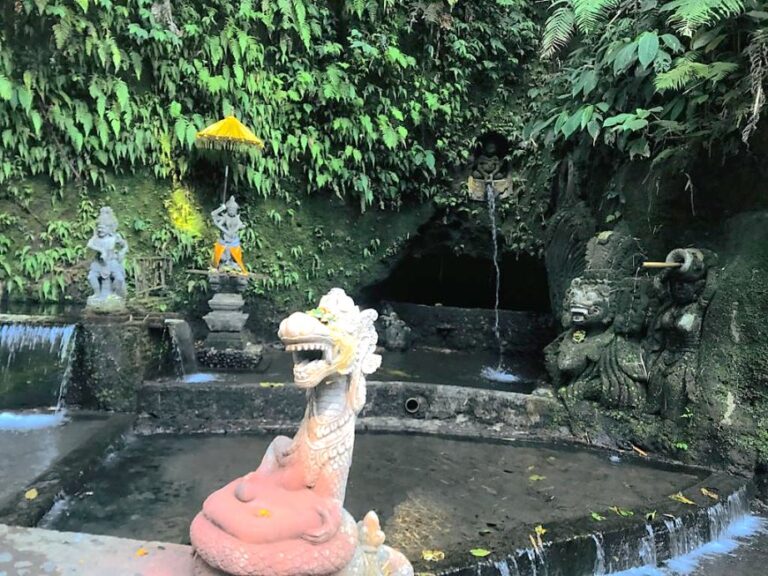Explore the Beauty and Spirituality of Pura Tirta Empul
For more than a thousand years, Balinese Hindus have been captivated by the sacred springs of Pura Tirta Empul (Holy Water Temple). It is believed that these springs were created by the God Indra and possess healing properties. This ancient tradition still continues today, attracting not only worshippers but also tourists from around the world who come to marvel at its beauty and bathe in its blessed water.
A Visit from Barack Obama and Family
In June 2017, former US President Barack Obama, along with his wife Michelle Obama and their daughters Malia and Natasha, had the opportunity to visit and experience Tirta Empul during their holiday in Bali. This shows how this temple has gained recognition and admiration even from world leaders.
The Location and Cultural Significance
Tirta Empul Holy Water Temple is situated in the village of Manukaya, near Tampaksiring town in Gianyar Regency. It is located not far from Ubud, which is known as the cultural heart of Bali. The temple itself lies just below the Presidential Palace of Tampaksiring, which was built in 1957 by Indonesia’s first president, Soekarno. Both the palace and the temple offer breathtaking views that will leave you mesmerized.
Exploring the Temple Complex
Tirta Empul is a large temple complex that will take you at least 30 minutes to an hour to fully explore. Before entering the premises, it is customary to wear a sarong, which can be rented for a small donation at the entrance. Once inside, you will walk through a majestic stone gate called Candi Bentar into the outer courtyard known as Jaba Pura. At the end of this courtyard, you will find another Candi Bentar leading to the central courtyard. These gates are guarded by beautifully carved statues of Dwarapala, and a unique carving of Kala with fangs and open arms.
The Main Area: Jaba Tengah
As you enter the inner courtyard called Jaba Tengah, you will witness the main attraction of the temple – the holy springs. These springs create a large pool of crystal-clear water within the temple and flow through 30 waterspouts into two purification pools. Local Balinese and Hindu worshippers line up in these pools to perform a purification ritual known as ‘melukat’. The process involves dipping their heads under each waterspout, starting from the left side pool. However, there are two spouts specifically reserved for cleansing the dead and are prohibited for use in the ‘melukat’ ritual.
The Hidden Gem: Jeroan
Behind the purification pools lies another section of Tirta Empul Holy Water Temple called Jeroan. This inner courtyard is often overlooked by tourists but offers a serene atmosphere to relax after experiencing the hustle and bustle of the main area. This is where people come to pray, and it is adorned with large Hindu shrines that contrast beautifully with the white clothing worn by Balinese worshippers.
A Calm Retreat: Koi Pond
As you exit Tirta Empul, you will pass through a tranquil koi pond enclosed by walls on all sides. This secluded area provides a calm and relaxing atmosphere where fat koi fish lazily swim, awaiting their next meal.
The Significance and Legends
Tirta Empul Holy Water Temple is dedicated to Vishnu, the Hindu God of water. The founding of this temple dates back to 926 AD and is considered one of the holiest water sources in Bali. The Balinese believe that its creation involved a legendary battle between the powerful king Mayadenawa and the God Indra. Mayadenawa possessed magical powers but misused them for black magic. Indra defeated him, and in his rage, Mayadenawa created a poisonous pond to harm Indra’s army. In response, Indra pierced the ground with his staff, creating the healing springs known as Tirta Empul. This legend also explains the origin of the name ‘Tampak Siring’ which means ’tilted footprint’ due to Mayadenawa walking on his feet’s sides to leave no traces.
The blood that gushed from Mayadenawa when he transformed into a boulder formed the Petanu River, which was cursed for over a thousand years. It caused rice to grow rapidly but with an awful smell and tainted with blood. The Balinese commemorate the defeat of Mayadenawa every 210 days through a ritual called Galungan.
Conclusion
Pura Tirta Empul offers a unique blend of spirituality, history, and natural beauty that captivates both worshippers and visitors alike. Its sacred springs and stunning architecture provide a glimpse into Bali’s rich cultural heritage while offering a peaceful retreat from the outside world. A visit to this holy water temple is not only an opportunity for self-reflection but also an unforgettable experience that will leave you with a deep sense of tranquility.



